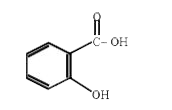What is the action of 2, 4-dinitrophenyl hydrazine on acetone ?
To understand the action of 2,4-dinitrophenyl hydrazine on acetone, we can break down the reaction step by step.
1. Identify the Reactants:
- The reactants in this reaction are acetone (C3H6O) and 2,4-dinitrophenyl hydrazine (C6H4(N2O4)NH2). Acetone is a ketone, and 2,4-dinitrophenyl hydrazine is a reagent commonly used to form hydrazones with carbonyl compounds.
2. Reaction Mechanism:
- When 2,4-dinitrophenyl hydrazine is added to acetone, it reacts with the carbonyl group (C=O) of acetone. The nitrogen atom from the hydrazine attacks the carbon atom of the carbonyl group.
3. Formation of the Intermediate:
- This attack leads to the formation of a tetrahedral intermediate. The oxygen of the carbonyl group becomes negatively charged (alkoxide ion) and is protonated by a nearby hydrogen ion (H+ from the medium).
4. Elimination of Water:
- The tetrahedral intermediate collapses, leading to the elimination of a water molecule (H2O). This step is crucial as it helps in the formation of the final product.
5. Formation of the Hydrazone:
- After the elimination of water, the product formed is a hydrazone. Specifically, the product is 2,4-dinitrophenyl hydrazone of acetone. The structure of this compound includes the 2,4-dinitrophenyl group attached to the nitrogen of the hydrazone linkage (C=N).
6. Final Product:
- The final product can be represented as C6H4(N2O4)NH-C(=N)-C3H6, where the nitrogen is now part of a double bond with the carbon of the former carbonyl group of acetone.
Summary of the Reaction:
The reaction can be summarized as:
Acetone+2,4-Dinitrophenyl Hydrazine→2,4-Dinitrophenyl Hydrazone of Acetone+Water
- The reactants in this reaction are acetone (C3H6O) and 2,4-dinitrophenyl hydrazine (C6H4(N2O4)NH2). Acetone is a ketone, and 2,4-dinitrophenyl hydrazine is a reagent commonly used to form hydrazones with carbonyl compounds.
- When 2,4-dinitrophenyl hydrazine is added to acetone, it reacts with the carbonyl group (C=O) of acetone. The nitrogen atom from the hydrazine attacks the carbon atom of the carbonyl group.
- This attack leads to the formation of a tetrahedral intermediate. The oxygen of the carbonyl group becomes negatively charged (alkoxide ion) and is protonated by a nearby hydrogen ion (H+ from the medium).
- The tetrahedral intermediate collapses, leading to the elimination of a water molecule (H2O). This step is crucial as it helps in the formation of the final product.
- After the elimination of water, the product formed is a hydrazone. Specifically, the product is 2,4-dinitrophenyl hydrazone of acetone. The structure of this compound includes the 2,4-dinitrophenyl group attached to the nitrogen of the hydrazone linkage (C=N).
- The final product can be represented as C6H4(N2O4)NH-C(=N)-C3H6, where the nitrogen is now part of a double bond with the carbon of the former carbonyl group of acetone.
The reaction can be summarized as:
Acetone+2,4-Dinitrophenyl Hydrazine→2,4-Dinitrophenyl Hydrazone of Acetone+Water
Similar Questions
Knowledge Check
What is the action of SAHELI ?
AAntiestrogenicBAntiprogesteronicCReleasing progesterone prevents implantationDRelesing copper inhibits motility of sperms2 : 4 Dinitrophenyl hydrazine is an example for
ATridentate ligandBMonodentate ligandCPolydentate ligandDDidentate ligandWhich one of the following compounds will give orange precipitate when treated with 2,4- dinitrophenyl hydrazine ?
A B
B C
C D
D
